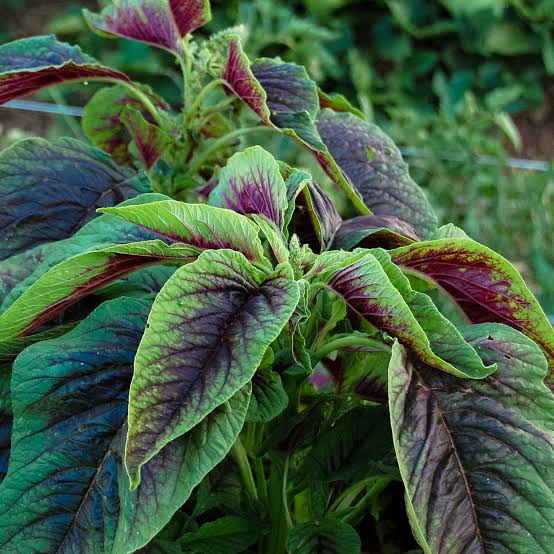If you’re curious about exploring some of nature’s treasures, let’s look at callaloo, also known as amaranth greens. This leafy green is not only a delightful addition to meals but also a powerhouse of health benefits.
Indigenous to West Africa, callaloo has made its way into Caribbean cuisine and beyond, bringing along a wealth of nutritional goodness.
What is Callaloo?
Callaloo typically refers to the leaves of the amaranth plant (Amaranthus viridis) or the taro plant (Xanthosoma sagittifolium). In many Caribbean cultures, it’s a staple dish, but its origins trace back to West Africa, where it has been cherished for centuries.
Its vibrant green leaves are rich in nutrients and often cooked in a variety of dishes, like soups and stews, making it both versatile and delicious.
Nutritional Benefits of Callaloo
Callaloo is packed with nutrients that make it a fantastic addition to your diet.
Here’s why you should consider incorporating it into your meals:
- Vitamins and Minerals: Callaloo is abundant in vitamins A, C, and K. Vitamin A supports eye health and immune function, vitamin C aids in collagen production and boosts immunity, and vitamin K is vital for bone health and blood clotting.
- High in Fiber: The fiber content in callaloo promotes digestive health, helps maintain a healthy weight, and keeps you feeling full longer.
- Antioxidant Properties: Callaloo is rich in antioxidants that fight free radicals in the body. This can help reduce the risk of chronic diseases and improve overall health.
- Low in Calories: Being low in calories makes callaloo an excellent choice for those looking to maintain or lose weight while ensuring they get the necessary nutrients.
Callaloo as a Natural Remedy
Beyond its nutritional benefits, callaloo has been used traditionally as a natural remedy.
Here are some notable health benefits:
1. Supports Eye Health:
With its high vitamin A content, callaloo can be a boon for your eyes. This vitamin is essential for good vision and helps prevent age-related vision problems. Including callaloo in your meals can help keep your eyesight sharp.
2. Boosts Immunity:
Thanks to its vitamin C content, callaloo plays a role in enhancing your immune system. A strong immune system can help fend off colds and flu, keeping you healthy throughout the year.
3. Promotes Healthy Digestion:
The fiber found in callaloo is excellent for your digestive system. It aids in preventing constipation and promotes regular bowel movements. Maintaining good digestive health is crucial for overall wellness, as it helps with nutrient absorption.
4. Reduces Inflammation:
Callaloo contains compounds that can help reduce inflammation in the body. Chronic inflammation is linked to many diseases, so incorporating callaloo into your diet can be a proactive way to manage your health.
5. Supports Bone Health:
Thanks to its vitamin K content, callaloo is great for maintaining healthy bones. Vitamin K helps improve bone density and reduce the risk of fractures.
Ready to grow your own delicious fruits and vegetables? Visit our store to check out our range of top-quality affordable seedlings to find the perfect plants for your garden!
How to Incorporate Callaloo into Your Diet
So, how can you enjoy callaloo in your meals? Here are some simple and delicious ways to incorporate this nutritious green:
1. Sautéed Callaloo:
A quick and easy way to enjoy callaloo is to sauté it with garlic and olive oil. Just add a pinch of salt and pepper for flavor, and you’ve got a delicious side dish to complement grilled meats or rice.
2. Callaloo Soup:
For a hearty meal, try making callaloo soup. Simmer the leaves with onions, garlic, and vegetable broth, then blend until smooth. Adding coconut milk can give it a creamy texture and delightful flavor.
3. Callaloo Smoothie:
Feeling adventurous? Toss some fresh callaloo into your morning smoothie. Blend it with banana, mango, and almond milk for a refreshing and nutritious start to your day. You might be surprised how delicious it can be!
4. Callaloo Omelette:
Add some sautéed callaloo to your omelet for a nutritious breakfast that’s both tasty and filling. It’s an excellent way to start your day with a burst of vitamins.
Growing Your Own Callaloo
If you’re excited about the benefits of callaloo, why not grow your own? It’s relatively easy to cultivate in a home garden.
Here are a few tips to get you started:
- Choose the Right Location: Callaloo loves warm, sunny spots, so find a location where it can soak up plenty of sunlight.
- Soil Preparation: Make sure the soil is rich and well-draining. Mixing in compost can help provide the necessary nutrients.
- Watering: Keep the soil consistently moist, but be careful not to over water. Regular watering will help your callaloo thrive.
- Harvesting: You can start harvesting the leaves once they’re large enough to eat, usually about 6-8 weeks after planting. Regular harvesting will encourage new growth.
Ready to grow your own delicious fruits and vegetables? Visit our store to check out our range of top-quality affordable seedlings to find the perfect plants for your garden!
Final Thoughts
Adding callaloo into your diet is not only a delicious choice but also a smart one for your health. With its impressive nutritional profile and traditional uses as a natural remedy, callaloo can enhance your meals while providing numerous health benefits.
Whether you sauté it, blend it into smoothies, or enjoy it in soups, this leafy green is a fantastic addition to any diet.
So, why not give callaloo a try and experience the benefits of this wonderful green for yourself!
Ready to grow your own delicious fruits and vegetables? Visit our store to check out our range of top-quality affordable seedlings to find the perfect plants for your garden!
